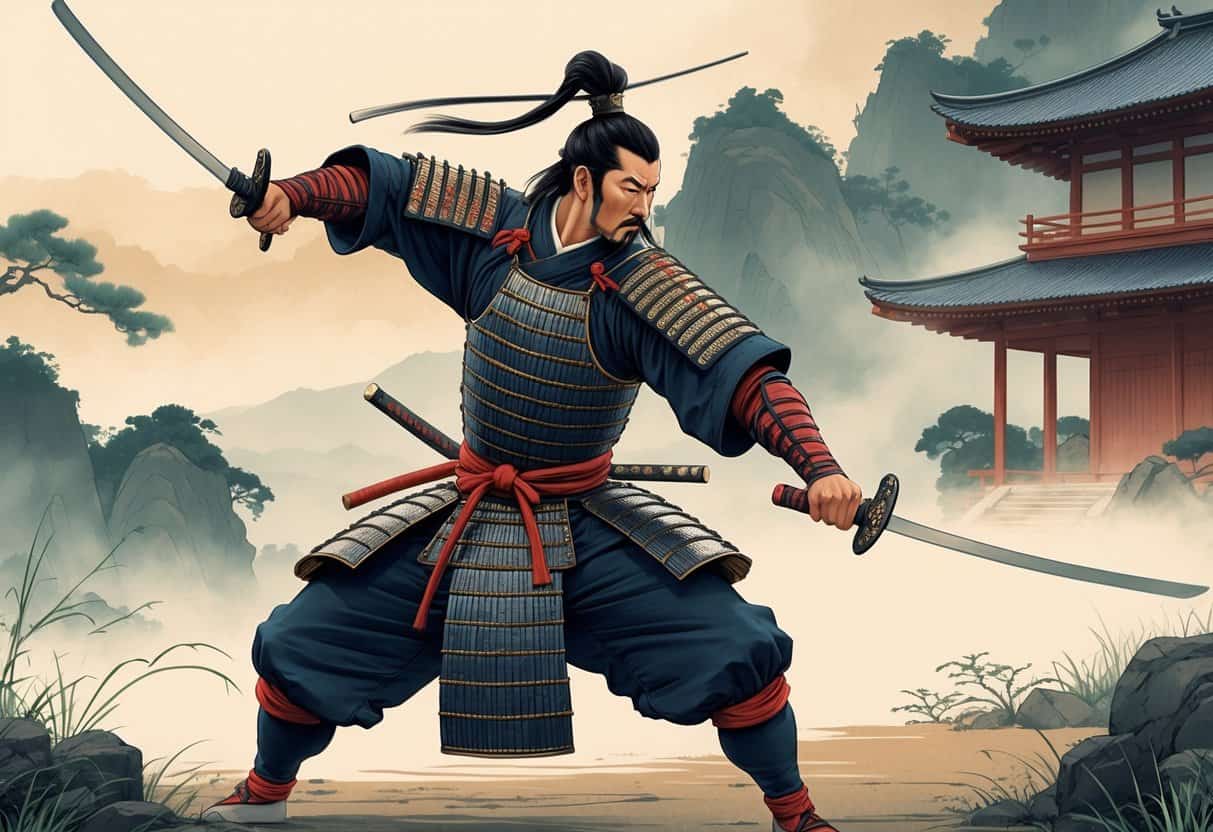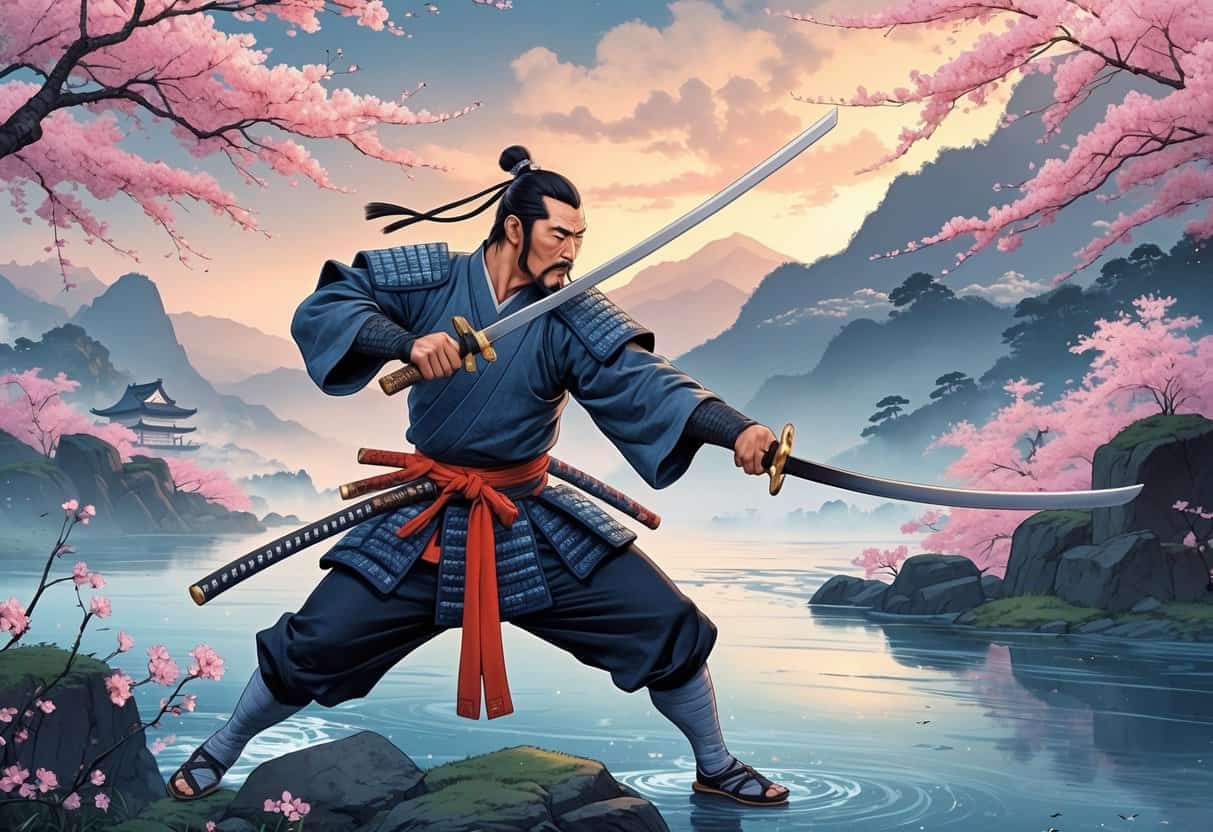Miyamoto Musashi stands as one of history’s most iconic swordmasters, his name echoing through tales of legendary duels and unmatched skill. He fought in over 60 battles and, remarkably, never lost.
His life’s story is a study in discipline and strategy. If you dig into his duels, you’ll see how precision, relentless practice, and a certain mindset all mesh together in the pursuit of mastery.

The most famous of his battles? That’d be the duel against Sasaki Kojirō in 1612, a fight that’s become the stuff of legend. Musashi’s approach was more brains than brawn—he leaned on clever tactics and timing, not just raw force.
Studying these fights, you’ll catch practical ways to rethink conflict and skill-building. There’s a lot more to it than swinging a sword around.
Musashi also left behind writings, putting heavy emphasis on constant practice and mental control. His ideas still ripple through martial arts and even business strategy today.
Curious about learning from a true master? His duels are a fascinating place to start.
Key Takeways
- Musashi’s story shows how skill and strategy intertwine in combat.
- His legendary duels are packed with lessons on timing and tactics.
- His writings hammer home the value of practice and mental focus.
The Life and Legacy of Miyamoto Musashi

Musashi’s life shaped both his sword skills and his lasting influence on Japanese martial arts. His early years, time as a ronin, and undefeated record all left a mark on the warrior’s path.
Early Years and Formative Experiences
Born in 1584 in Harima Province, feudal Japan, Musashi’s early life is a bit of a mystery. What’s clear is that he started training with the sword young.
By 13, he’d already fought and won his first duel. That’s not something you hear every day.
His family had samurai roots, but Musashi pushed himself further. He didn’t just stick to one style—he explored, experimented, and sharpened his skills wherever he could.
Those early fights? They shaped his independent streak and set him up for the life he’d lead.
Ronin Status and Travels
Musashi became a ronin—a masterless samurai—which gave him the freedom to roam. No lord to answer to, just the open road and the next challenge.
He wandered across Japan during the Edo period, always on the lookout for duels with other swordsmen. It was all about testing himself, not chasing money or fame.
This wandering life was full of challenges. He faced countless opponents, always focused on getting better.
His travels exposed him to all sorts of fighting styles. That’s how he developed his unique double-bladed technique.
Mastery in Swordsmanship
Musashi’s record? Over 60 duels, zero losses. That’s wild.
His edge wasn’t just skill, but strategy and a deep grasp of combat. He used a two-sword technique—niten ichi-ryū—which most samurai didn’t even attempt.
Speed, timing, and unpredictability were his trademarks. If you look at his duels, you’ll see how he adapted under pressure.
His book, The Book of Five Rings, lays out his philosophy on strategy and swordsmanship. It’s still a must-read for martial artists.
Influence on Japanese Martial Arts
Musashi’s impact goes way beyond his own fights. He helped shape Japanese martial arts and the whole concept of the warrior’s path.
He wasn’t just a fighter—he was a thinker, even an artist. He dabbled in calligraphy and poetry, too.
A lot of martial artists today still study his methods, trying to find that sweet spot between mind, body, and technique.
Famous Duels and Swordmaster Tactics
Let’s look at the key duels that built Musashi’s reputation. Each fight reveals something about his skill, his strategies, and the kind of opponents he faced.
First Duel and Early Battles
Musashi’s first recorded duel happened when he was just a teen. He took down Arima Kihei, a swordsman from the Shinto-ryu school.
That early win set the tone for his life as a solo duelist.
He also fought in big battles like Sekigahara and Osaka. Those weren’t just duels—they were full-scale wars, giving him a taste of real combat.
Facing different warriors and large forces forced him to stay flexible. He learned timing, distance, and unpredictability.
It wasn’t about brute force. Musashi read his opponents and adapted on the fly.
Duel with Sasaki Kojirō
The showdown with Sasaki Kojirō is probably Musashi’s most famous moment. It happened on Ganryu Island in 1612.
Kojirō was famous for his long sword technique, the “Tsubame Gaeshi” or “Swallow Counter.” Not exactly an easy opponent.
Musashi showed up late—on purpose—to mess with Kojirō’s head. He fought with a wooden sword carved from a boat oar, which gave him a reach advantage.
When the fight started, Musashi struck first and ended it fast. The whole thing was a lesson in timing, mental games, and picking the right weapon.
Yoshioka-ryū Dojo Confrontations
Musashi tangled with the Yoshioka-ryū school more than once. This dojo had serious backing from the Hosokawa family and the shogunate.
The rivalry was intense. Musashi faced multiple opponents, sometimes all at once.
He focused on single combat, dodging their group tactics and traps. His approach mixed aggressive offense with smart defense.
These battles showed how he could handle pressure—even when the odds were stacked against him.
Encounters Against Notable Opponents
Musashi’s career is dotted with duels against skilled fighters, like Funajima (a student of Tsukahara Bokuden) and swordsmen linked to the Tokugawa shogunate.
He was always adapting to new sword styles. His two-sword technique, “Niten Ichi-ryū,” let him attack and defend at the same time.
He didn’t care much for traditional dojo rules. It was all about what worked in real combat.
Facing samurai from rival clans, Musashi relied on timing, positioning, and surprise. That’s what kept him undefeated.
Philosophy, Techniques, and Writings
To get Musashi, you’ve got to look at his ideas, fighting style, and what he wrote down. His approach blends martial arts with deep strategy and a bit of life philosophy.
The Book of Five Rings and Martial Philosophy
His most famous work? The Book of Five Rings (Go Rin No Sho). It’s all about strategy, combat, and the mindset you need to win.
He talks a lot about timing, rhythm, and perception. It’s not just about swinging a sword; it’s about being a strategist.
Musashi believed success came from clear thinking and adaptability. Not just in battle, but in life too.
The book splits knowledge into five elements: Earth, Water, Fire, Wind, and Void. Each one stands for a different lesson in martial arts and conflict.
Hyoho Niten Ichi-ryū and Kenjutsu
Musashi founded Hyōhō Niten Ichi-ryū—that’s his school of kenjutsu. It’s famous for the two-sword style.
The name means “Two Heavens as One School.” In practice, you’re fighting with a katana and a wakizashi at the same time.
This style is all about offense and defense flowing together. Timing, distance, and balance are everything.
The techniques are practical and quick to adapt. It’s not about looking pretty; it’s about what works.
Double-Bladed Swordsmanship
The double-bladed method is a huge part of Musashi’s strategy. Most samurai stuck to one sword, but he trained to use both with precision.
It takes serious coordination and a sharp mind. Each hand has to work with the other.
This approach gave him more options in attack and defense. During a duel, that extra flexibility could be the difference between winning and losing.
He used bokken (wooden swords) for training. Safer, but still effective for building skill.
His undefeated streak? Proof that this style worked for him.
Elements of Strategy and Tactics
For Musashi, strategy (heiho) was bigger than just fighting moves. It meant planning, watching, waiting, and knowing your opponent.
He encouraged learning from different arts, not just swordsmanship. That keeps your mind sharp.
His tactics were about creating chances, not forcing things. Sometimes you strike, sometimes you wait.
You’ve got to read the situation and change plans as needed. Staying calm and keeping control is key.
These lessons apply to life, not just martial arts.
| Key Principles | Meaning |
|---|---|
| Timing (Maai) | Control of distance and rhythm |
| Adaptability | Change tactics based on conditions |
| Awareness | Observe opponents and your surroundings |
| Mindset | Stay calm, focused, and confident |
Mastering these? That’s what real martial mastery looks like.
Cultural Impact and Artistic Legacy
Musashi’s influence isn’t just about sword fights. His life mixed combat with art and philosophy, blending strength with wisdom.
You’ll spot his legacy in books, paintings, and martial arts even now.
Influence on Literature and Popular Culture
Musashi pops up everywhere in stories and movies. Eiji Yoshikawa’s novel Musashi really shaped how people picture the samurai life.
It’s a mix of fact and fiction—Musashi’s journey through Tajima Province, battles near Kumamoto Castle, and all that.
His undefeated record and double-sword technique make him a symbol of mastery and resilience. There’s a real fascination with his simple, disciplined lifestyle.
You’ll also see links to traditional schools like Enmei-ryū and Kashima Shintō-ryū. The real martial arts roots are never far from the legend.
Musashi as a Painter and Writer
He wasn’t just a swordsman—Musashi was a painter and calligrapher, too. His art often reflects his philosophy: earth, water, fire, wind, and void.
His writing, especially The Book of Five Rings, uses nature as a metaphor for strategy. It’s still read for its insights on focus and adaptability.
His creative side brings out a different image—a warrior with a thoughtful, even artistic, streak.
Enduring Symbolism in Modern Martial Arts
Today, Musashi’s influence shows up in martial arts schools everywhere. His strategies from The Book of Five Rings guide fighters well beyond just swordplay.
They’re not just about technique—they’re about mindset, timing, and reading your opponent. It’s interesting how his ties to natural elements still shape martial arts philosophies.
Modern practitioners often see Musashi as a symbol of mastering both body and mind. His story, from Tajima Province to those legendary duels, pushes people toward discipline and lifelong learning.
Musashi’s legacy nudges you to remember that real skill comes from steady effort and keeping your cool inside.